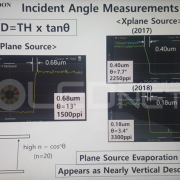Is accelerating the localization for FMM, which can realize ultra-high resolution?
Since Fine Metal Mask (FMM) plays a role of depositing pixel and RGB organic materials, FMM is a factor that determines the resolution and yield of OLED. However, FMM is currently confronted with some limitations that thermal expansion occurs during the deposition process or shadow effects arise due to its weight.
In addition, the total amount of FMM is imported at high prices in the form of finished products which are made by Japanese Dainippon Printing (DNP)’ etching process with the rolled invar produced by Hitachi Metals.
Under the circumstances, domestic and overseas related industries are concentrating on developing FMM in various ways such as laser processing, but they are still in R & D stage.
The research team of Professor Park Yong-Bum of New Material Engineering Department of Sunchon University announced on 9th May that it succeeded in developing the technology of electroforming invar manufacturing technology. This is a technique for separating the metal attached to the cathode while utilizing the electroplating, and making FMM.

<Thermal expansion curves and microstructure of electroforming invar, source: Suncheon University>
According to the research team, invar can be produced as a sheet material, and the shape of the patterned cathode can be copied as it is, through this technology. In addition, the thickness of FMM can be reduced to about 7μm, about half the thickness of the current FMM, which might be helpful to realize super high image quality.
Professor Park said, “The level of Japanese research on the electroforming invar has been pursued to the bottom of our research team, and China has entered into development with a large amount of capital.” In order for Korean companies to gain international competitiveness, I thought the academic circles needed to support it actively. Consequently, I have decided to publish all the databases that have been built and researched for nearly 20 years through papers.”
Attention is focused whether it is to be successful in localizing FMM, the total amount of which has been imported.










